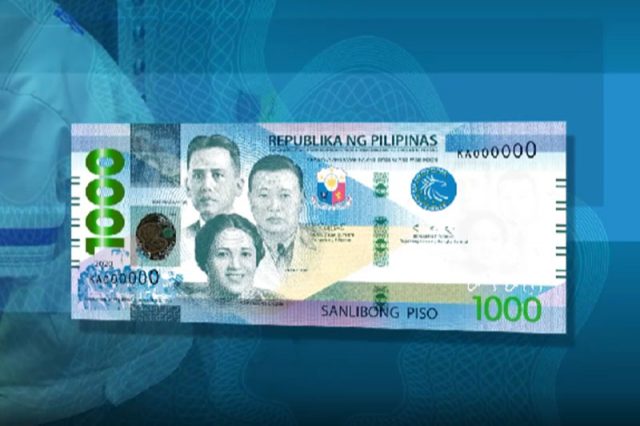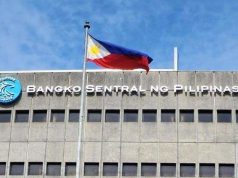
The Bangko Sentral ng Pilipinas (BSP) was asked about its priorities after it decided to change the design of the P1,000 banknote from historical figures to that of a Philippine eagle.
Central bank Gov. Benjamin Diokno on Saturday said that the new design is part of the new series to be rolled out in the fourth week of April 2022.
The new series will focus on the “fauna and flora in the Philippines.”
Diokno said that the BSP came up with the new design which was approved by the National Historical Commission of the Philippines.
Its issuance was also approved by BSP’s Monetary Board and the Office of the President.
The banknote will also be made from polymer instead of cotton and abaca, which BSP said is more hygienic, sustainable, durable and cost-effective. It also said that these will be water and dirt-resistant, making them more suitable for transactions in wet markets.
The BSP regularly redesigns and updates features of banknotes and coins as anti-counterfeiting measures.
Last October, it announced that it has been authorized to circulate 500 million pieces of the polymer-based P1,000 banknotes as part of a test for its adoption.
The current design of the P1,000 bill shows three martyred Filipinos who died during the Japanese occupation of the Philippines in World War 2.
These are Josefa Llanes Escoda, Vicente Lim and Jose Abad Santos.
The move to remove them from the banknote didn’t sit well with some Filipinos who questioned the central bank’s “priorities” amid a pandemic.
“This is not an either-or debate. Time for the BSP Governor to face the mirror [and] ask: Amidst the pandemic, what are your priorities?” blogger Kristoffer Pasion, who describes himself as a history lover, tweeted in response to the reports.
“Marami pa pong problema ang bansa, and here we are changing designs ng pera again,” wrote another Twitter user.
“Mas may pake pa sa itsura ng pera, hindi dun sa nawawalang halaga nito. At ‘yung napakaraming tao na wala nito,” Dr. Gene Nisperos, board member of the Community Medicine Development Foundation, also tweeted.
The BSP in a report said that “public concerns” prompted them to make initiatives to transition to polymer-based banknotes sooner.
The wake of the COVID-19 pandemic has made it more habitual for people to sanitize their hands after touching banknotes in cash transactions.
Diokno said that a polymer banknote’s chemical component makes its surface smooth and supposedly resistant to dirt, bacteria and viruses.
A day after announcing the P1,000 bill’s new design, the BSP said the design was not yet final and that it was just a “sample” that previously sent to them “for review.”
Faces of the current P1,000 bill
Escoda is the founder of the Girl Scouts of the Philippines who played a role in offering aid to Filipinos soldiers during the Japanese occupation.
She was also known for her determination and yearning to be educated from a young age. After graduating as a valedictorian, she joined the Red Cross where she became a social worker.
Escoda was also a strong advocate for female suffrage who fought for women’s involvement in the Philippine government through the National Federation of Women’s Clubs.
During World War 2, she served prisoners of war and civilian internees. She also secretly provided personal and medical supplies to hostages in different camps even after her husband was captured.
Escoda was arrested by the Japanese military in 1944 and was executed the following year.
Lim, meanwhile, was a brigadier general who served as an Army infantry officer during World War 2.
He fiercely campaigned for better equipment and training for his soldiers.
Carlos Romulo, who was an aide of Gen. Douglas MacArthur, described Lim as “the embodiment of the Philippine Army in Bataan: ragged, starved, sick unto death, beaten back hour after hour — but invincible.”
Lim was a survivor of the Bataan Death March who built, financed, and led resistance fighters against the Japanese forces.
He was eventually executed for being a resistance leader.
Abad Santos, on the other hand, was a Supreme Court chief justice who was trusted by former President Manuel L. Quezon for his “remarkable legal expertise and steadfast temperament.”
Prior to this, Abad Santos served as a justice secretary for various American governors-general in the country.
When Quezon invited him to join his government-in-exile at Washington during World War 2, Abad Santos declined and said that he preferred to remain in the Philippines to carry on his work and stay with his family.
The then-president appointed him as his “delegate” instead, making Abad Santos an acting president of the Commonwealth Government.
He was eventually captured by the Japanese forces in 1942 but he refused to take an oath of allegiance to Japan, which lead to his execution.








